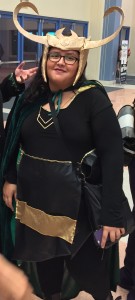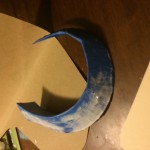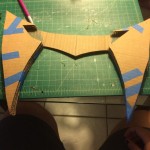As our summer cosplay series winds to an end, Jennifer, a self-admitted “not crafty” person talks about semi-homemade cosplaying and how to get start out easy and build up to more advanced cosplay techniques.

I am not crafty. I have a horrible track record with attempting to knit and a basket full of unfinished scarves (if you can call the knotted yarn I tried to knit a scarf). My Halloween costumes are usually whatever requires the least amount of crafting—if I cannot buy every piece of my costume, it’s time for a new idea.
So, as much as I completely suck at crafting, I love cosplay. I love the amount of passion and dedication that goes into planning and successfully executing a cosplay. I love that seeing a good cosplay of a character I love can actually make me emotional (yes, I have cried over Rose Quartz cosplay).
I spend so much of my time planning potential cosplays only to throw up my arms in despair ten minutes later when I realize, yet again, that I am not crafty. A lifetime of failed clothes mods and sculpting (it was just once… but it was bad) has made cosplay seem just really unattainable to me. I’ve always felt that if I could not make or modify every piece of a cosplay myself, I was not actually doing it. I worry that I’m not a real cosplayer, if I don’t sew every stitch or mold each boot buckle from molten iron (I have no idea where I would even do this). Obviously, this is ridiculous; but my brain is cruel. Lindsay talked about a lot of these feelings of worry associated with cosplay in her piece, Fail Better: Cosplay Virgin – Neuroticism May Cause Cosplay Abstinence.

Recently, in an effort to combat those feelings of craft failure, I’ve started focusing on what I like to call semi-homemade cosplay (I watch a lot of Food Network, sue me). Semi-homemade cosplay focuses more on taking completed pieces and altering them, similar to that logic Sandra Lee applies to all those “Cocktail Time” drinks. Since I have not actually successfully completed a cosplay (YET), I spoke to two friends, Martha and Devin, about a few of their projects. Each of them is at a different point in their cosplay career, so they’ve got different levels of expertise in terms of crafting and modifying completed pieces.
Martha is a former architecture major, so… they can craft. They just debuted their first cosplay project at Florida Supercon in June. To really capture that Loki vibe (on a budget), Martha studied comic panels, movies, and other cosplays. They bought a basic black lycra dress to use as the base, cutting and sewing the dress to their liking. Once the dress fit the specifications they desired, they attached separate pieces they had made out of faux leather, green polyester cloth, and wire-trimmed gold ribbon. It’s a pretty basic cosplay: a store-bought dress and some extra stuff you can find at a craft store. The most difficult thing to work with, according to Martha, was actually the store-bought dress (Is nothing safe anymore!?). The material, lycra, doesn’t really stay in place, so you need to find a way (other than pins) to keep it secure.
Probably the most impressive (and my favorite) part of this cosplay is the helm. The thought of even trying to recreate it made me want to crawl under my bed and hide. Then, I found out what it was made of: cardboard, blue tape, and paint. That’s right, only three things. Three things that, on their own, seem harmless enough. Cardboard stores all of my favorite things: cereal, cookies, vintage books. What is less scary than cardboard? Probably a lot of things, but… you get what I’m saying. Cardboard is a great way for beginners to get a feel for what it’s like to make their own props without investing a lot of money and effort into modifying more expensive materials. This helm is the perfect example of what you can do with basic objects.

For cosplayers who are a little more confident in their skills, there are definitely ways to increase the complexity of your semi-homemade cosplay. Devin, a 4-year cosplay participant and cofounder of ArtyTime Ink, has definitely learned how to do just that.
She starts off almost every cosplay with purchased base items. In her most recent project, as Coco from RWBY, Devin started off with a standard brown turtleneck, black corset, black boots, and black cargo capris. She’s made several modifications to each piece to suit her needs, including eliminating clips and lace from the corset to replace it with a belt strap, sewing extra pockets on to the pants and dyeing the leather on her shoes.
Devin spent a large portion of her time modifying the cargo pants. Finding the right thread for the mods involved looking through a lot of cotton synthetics (… I was not aware that there was a wrong thread; isn’t there only one?). She mentioned that her sewing can often end up a little loose, so she uses a combination of hand sewing, a portable sewing machine, and fabric glue (and sometimes krazy glue).
Recently, she started experimenting with Worbla, a thermoplastic modeling material. From what I’ve heard, Worbla is one of those materials that you want to have some guidance for; it’s not that cheap and the learning curve can be pretty steep. Devin is working on molding the Worbla into a buckle. This involves some layering of the material and, later, filling in cracks with caulk. So, this is… a little advanced. It definitely sounds like something to work up to.
For those of us who hope to one day get to the point where figuring out exactly how many layers of Worbla to use becomes a problem, Devin has a few pointers:
- Pick an easy cosplay first. Something that requires a uniform or everyday clothes is best because customizing base clothes eat up a lot of your time.
- Consider money. Budget everything out before you start to save yourself the impending panic when you realize that you’ve burned through most of your Worbla supply.
- Thin, stretchy materials are your best friends. Materials like spandex are pretty easy to work with, but require some finesse to maneuver. To avoid problems like the ones Martha experienced when using lycra, try wearing the material while tweaking it. Devin also suggests making a duct tape mannequin, but I’m pretty sure that would eat up so many afternoons for me. Who doesn’t want a duct tape mannequin in their room?
- Online tutorials are great. There are so many awesome tutorials online that can teach you how to manipulate different materials, dye things without ruining them, and maintain cosplay wigs. Devin is actually working on a Rose Quartz (I’m squee-ing already!!!!) cosplay with the help of a hoop skirt tutorial.
- Have fun. It’s so easy to get stressed out by something that is supposed to be fun. Cosplay is not a competition (unless you’re entering one): “It’s about you loving your character and expressing that love and meeting cool people.”
In the words of Briana Lawrence, “Just go out there and do it!”










